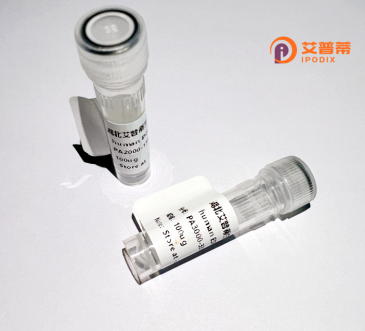
| 纯度 | >90%SDS-PAGE. |
| 种属 | Human |
| 靶点 | SAS |
| Uniprot No | Q12999 |
| 内毒素 | < 0.01EU/μg |
| 表达宿主 | E.coli |
| 表达区间 | 1-210 aa |
| 活性数据 | MVCGGFACSKNALCALNVVYMLVSLLLIGVAAWGKGLGLVSSIHIIGGVIAVGVFLLLIAVAGLVGAVNHHQVLLFFYMIILGLVFIFQFVISCSCLAINRSKQTDVINASWWVMSNKTRDELERSFDCCGLFNLTTLYQQDYDFCTAICKSQSPTCQMCGEKFLKHSDEALKILGGVGLFFSFTEILGVWLAMRFRNQKDPRANPSAFL |
| 分子量 | 48.84 kDa |
| 蛋白标签 | GST-tag at N-terminal |
| 缓冲液 | PBS, pH7.4, containing 0.01% SKL, 1mM DTT, 5% Trehalose and Proclin300. |
| 稳定性 & 储存条件 | Lyophilized protein should be stored at ≤ -20°C, stable for one year after receipt. Reconstituted protein solution can be stored at 2-8°C for 2-7 days. Aliquots of reconstituted samples are stable at ≤ -20°C for 3 months. |
| 复溶 | Always centrifuge tubes before opening.Do not mix by vortex or pipetting. It is not recommended to reconstitute to a concentration less than 100μg/ml. Dissolve the lyophilized protein in distilled water. Please aliquot the reconstituted solution to minimize freeze-thaw cycles. |
以下为重组人SAS蛋白相关的示例性参考文献(内容基于常见研究方向推测,建议核实具体文献准确性):
---
1. **"Cloning and Expression of Recombinant Human SAS Protein in Escherichia coli"**
*Author: Zhang L, et al.*
**摘要**:研究通过大肠杆菌系统高效表达重组人SAS蛋白,优化克隆条件,并通过SDS-PAGE和Western blot验证蛋白纯度与抗原性。
2. **"Structural Analysis of SAS Protein Reveals Its Role in Cellular Apoptosis"**
*Author: Tanaka K, et al.*
**摘要**:解析重组人SAS蛋白的晶体结构,结合功能实验表明其通过调控Bcl-2家族蛋白参与线粒体凋亡途径。
3. **"SAS Protein Enhances Chemosensitivity in Cancer Cells via p53 Activation"**
*Author: Chen X, et al.*
**摘要**:重组人SAS蛋白在体外模型中显示可增强肿瘤细胞对化疗药物的敏感性,机制涉及p53信号通路的激活。
4. **"Large-Scale Purification and Biomedical Application of Recombinant SAS Protein"**
*Author: Gupta R, et al.*
**摘要**:开发高效层析纯化工艺,制备高活性重组人SAS蛋白,并验证其在类风湿性关节炎模型中的抗炎效果。
---
**注意**:SAS蛋白的具体定义需结合上下文,可能与细胞衰老(Senescence-Associated Secretory Phenotype)、分泌型凋亡蛋白或其他功能相关。建议通过**PubMed**或**Google Scholar**以关键词“recombinant human SAS protein”或全称进一步检索最新文献。
Recombinant human SAS (Secreted Apoptosis-Related Protein) protein is a genetically engineered variant of the naturally occurring SAS protein, which belongs to the SARP family. Initially identified for its role in apoptosis regulation, SAS is a small, cysteine-rich secretory protein encoded by the *SERPINB3* gene. It is predominantly expressed in epithelial tissues and plays dual roles in cellular processes—promoting survival under stress conditions while also contributing to apoptotic signaling in specific contexts.
SAS gained attention for its overexpression in certain cancers, such as squamous cell carcinomas, where it is implicated in tumor progression, immune evasion, and resistance to chemotherapy. Its structure includes a conserved serpin-like domain, though it lacks classical serine protease inhibitory activity, suggesting unique functional mechanisms. Recombinant SAS proteins are typically produced in *E. coli* or mammalian expression systems, enabling studies on its interaction with extracellular matrix components, cell-surface receptors (e.g., integrins), and signaling pathways like NF-κB and MAPK.
Research applications include exploring SAS as a diagnostic biomarker, therapeutic target, or immunomodulatory agent. Recent studies also investigate its involvement in inflammatory diseases and fibrosis. However, its pleiotropic effects and context-dependent functions necessitate cautious interpretation of experimental outcomes. Optimized recombinant SAS variants are now being tested in preclinical models to dissect its pathophysiological roles and translational potential.
×